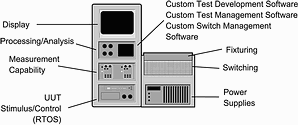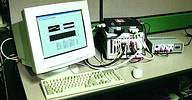
Electronics manufacturers today are faced with unprecedented cost and time-to-market pressures. Test engineers working for OEMs and contract electronic manufacturers are hard pressed in justifying the costs of new and improved test equipment, yet struggle to bring new technologies to market on time without it. It is a catch 22 that has forced many electronic manufacturers to consider used or leased automated test equipment (ATE) systems as a way to minimise the impact on the bottom line, however, neither approach offers cost savings today as well as a sound investment strategy for the future.
As technology has continued to evolve, commercial technologies have developed that now parallel and often eclipse the capabilities of dedicated, proprietary ATE systems. Just as computers that once filled entire rooms have shrunk in size with steadily increasing capability, sophisticated ATE is now available for desktop use with the cost, flexibility, and performance demanded by a large number of engineers.
In the past, engineers requiring a high-end automated test system had few choices - they typically purchased a tester from a test-systems integrator built largely on proprietary hardware and software. These systems took months to develop, cost hundreds of thousands of dollars, and left users highly dependent on the vendor. An example of typical proprietary ATE is represented in Figure 1. Building ATE systems on an open, modular hardware platform like PXI (PCI eXtensions for Instrumentation) can dramatically lower the cost to test. In addition to a low initial investment, PXI systems can evolve with a company and its products into the future.

The state of the ATE market resembles the automotive market about 100 years ago. In 1907, Henry Ford made bold claims to change the way automobiles were manufactured. He referred to this as 'democratising the automobile'.
Proprietary ATE is similar to the pre-1907 automobiles. The vast majority of the world requires flexible and less expensive test solutions that take advantage of widely available commercial technology. By doing so, it is in essence 'democratising ATE', making it available to a very broad set of scientists and engineers for automated testing.
PXI combines the latest commercial hardware and software technologies with concepts and technologies derived from ATE, such as sophisticated timing and triggering for high-performance measurements. By exploiting commercial PC and digitising technologies, PXI provides the high performance of proprietary ATE, but at a much lower cost.

PXI truly makes it possible to have sophisticated ATE on a desktop. Further, PXI provides a diverse set of measurement and control capabilities, including vision, motion, and realtime control, providing important functionality integrated into the same platform as the traditional electrical measurements.
To fully deliver on the promise of PXI to provide a tightly integrated measurement and control platform, it is essential to have software architecture that defines a common interface to different types of hardware, instead of having vendor-defined 'silos' that communicate with each module in a PXI system. This software layer, which resides between the test development environments and the hardware, is called Measurement and Control Services. Measurement and Control Services include driver engines, flexible, high-level application programming interfaces (APIs), and a configuration manager. Although often hidden in a system, this software provides the glue to integrate hardware devices and often ends up being one of the most important elements of a system.
Another piece of most proprietary ATE systems is test management software, commonly called a Test Executive. The functions of this software include:
* Organising a set of test routines.
* Sequencing, branching, and looping through tests.
* Collecting and organising test results.
* Providing a consistent user interface to different tests.
Because this software is typically created for a single type of tester, however, it lacks flexibility and scalability. Further, it is not widely used and therefore is not adopted by a large set of users, integrators, and third parties.
Today, Test Executives are available from a number of vendors. They typically provide the ability to connect to a number of different test development tools and an array of reporting and databasing capabilities. These programs take much of the monotony out of creating, maintaining, and documenting a set of test programs. They ultimately make users more productive in creating test systems.
Just like test management software, switch management systems have long been used on ATE systems. They are used to name and organise channels, assist in switch routing, and manage routes through switch matrices. This functionality is essential to use medium-to-large switch matrices productively and manage switch routing, especially among multiple products under test. However, like propriety test management software, propriety switch management systems usually only worked on one vendor's test system and lacked flexibility and scalability.
Today, commercially available, intuitive switch management and routing software has alleviated this problem. Switch management and routing software provide switch management directly from the development environment or test management system, so the switching in a system becomes all but transparent to the test developer.
Taking full advantage of commercial technologies results in an automated test system that can fit the needs of electronics manufacturers. Building ATE systems on an open, modular hardware platform like PXI can dramatically lower the cost to test and provide sound investment strategy for the future.
For more information contact National Instruments South Africa, 0800 203 199.

© Technews Publishing (Pty) Ltd | All Rights Reserved